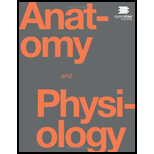
Concept explainers
Visit this website (http://openstaxcollege.org/l/lymphsystem) for an overview of the lymphatic system. What are the three main components of the lymphatic system?
To analyze:
Components of the lymphatic system.
Introduction:
The lymphatic system carries the interstitial fluid from the body and drains it back into the circulatory system. The blood plasma that oozes out of the blood vessels along with the white blood cells from the lymph.
Explanation of Solution
There are three main parts of the lymphatic system namely; the lymph nodes, the lymphatic vessels, and the lymph. The lymph nodes are the site for the production of the lymphocytes. The cortex region of the lymph nodes consists of the thymocytes that mature into the T-cells. The lymphatic vessels are tubular structures that carry the lymph throughout the body and the lymph is the fluid that circulates into the lymphatic system that carries the lymphocytes and the interstitial fluid throughout the body.
The lymphatic system consists of lymphatic nodes, vessels, and the lymph. It helps in collecting the interstitial fluid from the body and drain it back in the circulatory system. The nodes also produce lymphocytes that are added to the fluid, which is known as the lymph.
Want to see more full solutions like this?
Chapter 21 Solutions
Anatomy & Physiology
Additional Science Textbook Solutions
College Physics
Concepts of Genetics (11th Edition)
Campbell Biology: Concepts & Connections (9th Edition)
Campbell Biology: Concepts & Connections (8th Edition)
Campbell Essential Biology with Physiology (6th Edition)
Microbiology: An Introduction
 Anatomy & PhysiologyBiologyISBN:9781938168130Author:Kelly A. Young, James A. Wise, Peter DeSaix, Dean H. Kruse, Brandon Poe, Eddie Johnson, Jody E. Johnson, Oksana Korol, J. Gordon Betts, Mark WomblePublisher:OpenStax College
Anatomy & PhysiologyBiologyISBN:9781938168130Author:Kelly A. Young, James A. Wise, Peter DeSaix, Dean H. Kruse, Brandon Poe, Eddie Johnson, Jody E. Johnson, Oksana Korol, J. Gordon Betts, Mark WomblePublisher:OpenStax College Biology (MindTap Course List)BiologyISBN:9781337392938Author:Eldra Solomon, Charles Martin, Diana W. Martin, Linda R. BergPublisher:Cengage Learning
Biology (MindTap Course List)BiologyISBN:9781337392938Author:Eldra Solomon, Charles Martin, Diana W. Martin, Linda R. BergPublisher:Cengage Learning Human Biology (MindTap Course List)BiologyISBN:9781305112100Author:Cecie Starr, Beverly McMillanPublisher:Cengage Learning
Human Biology (MindTap Course List)BiologyISBN:9781305112100Author:Cecie Starr, Beverly McMillanPublisher:Cengage Learning





